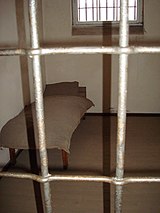Kurt Eccarius
Kurt Eccarius (born March 5, 1905 in Coburg ; † October 9, 1984 there ) was a German SS-Hauptscharführer who headed the detention area in the Sachsenhausen concentration camp between 1942 and 1945.
Life
Kurt Eccarius was the son of the ducal cellar master Robert Eccarius, he had two older siblings. After graduating from secondary school in his hometown in 1920, he completed an apprenticeship as a machine fitter and then worked in this profession for various companies. From 1923 she was unemployed at times and got by with odd jobs. He became a member of the NSDAP and SS in 1929 .
After the transfer of power to the National Socialists , he was an auxiliary police officer in his hometown from March to May 1933 and then joined the guard battalion of the Dachau concentration camp, where he was employed outside the protective custody camp as an instructor, accountant and finally as a platoon leader. In June 1936 he was transferred to the Columbia-Haus concentration camp , where he did paperwork for the camp leader. From November 1936 he was a member of the command staff of the Sachsenhausen concentration camp. Eccarius was initially deputy head and from August 1942 to April 1945 head of the cell construction (camp prison) in Sachsenhausen concentration camp, in which Sigismund Payne Best , Georg Elser , Martin Niemöller and Herschel Grynszpan , among others , were imprisoned. Eccarius was accused of grossly mistreating many prisoners.
After the end of the war, he was imprisoned and indicted in the Berlin Sachsenhausen trial before a Soviet military court with other accused for the crimes in the Sachsenhausen concentration camp. Eccarius was found guilty and sentenced to life imprisonment with compulsory forced labor on October 31, 1947, and imprisoned in the Gulag's Vorkuta labor camp . Due to the Adenauer intervention , however, he was released from Soviet custody in January 1956 and returned to the Federal Republic of Germany as a so-called non - amnesty . He then took a cure and worked from October 1956 to November 1962 as a pen in a porcelain factory in his hometown. From November 27, 1962, Eccarius had to answer to the jury court in Coburg for the shooting of prisoners on the night of April 28 to 29, 1945 when the Sachsenhausen concentration camp was dissolved. He was sentenced to four years in prison on November 30, 1962 for attempted manslaughter in six cases . The amount of the penalty triggered strong expressions of displeasure among the spectators.
Another trial against Eccarius and two other accused (Franz-Xaver Ettlinger and Kaspar Drexel) before the district court Munich II u. a. because of his participation in the murder of Soviet prisoners in the shot in the neck in the Sachsenhausen concentration camp ended on December 22, 1969 with his sentencing to eight and a half years imprisonment. Eccarius was released from prison after just two years due to incapacity for detention.
literature
- Wolfgang Benz , Barbara Distel (ed.): The place of terror . History of the National Socialist Concentration Camps. Volume 3: Sachsenhausen, Buchenwald. CH Beck, Munich 2006, ISBN 3-406-52963-1 , p. 38
- Ernst Klee : The dictionary of persons on the Third Reich . Fischer, Frankfurt am Main 2007. ISBN 978-3-596-16048-8 . (Updated 2nd edition)
- CF Rüter, L. Hekelaar Gombert, Dirk Welmoed de Mildt: GDR justice and Nazi crimes. Collection of East German convictions for Nazi homicide crimes. Amsterdam University Press, Amsterdam 2002, ISBN 9053565418
- Hermann Wentker: The legal punishment of Nazi crimes in the Soviet zone of occupation and in the GDR, In: Kritische Justiz , Heft 1, 2002
- Wolfgang Benz: The Sachsenhausen Process, In: Federal Agency for Civic Education , Issue 259 (Germany 1945-1949)
Web links
- Sachsenhausen Trial, List of Defendants
- Defendant Kurt Eccarius at the Sachsenhausen concentration camp was a crimes trial in Berlin. Single photo at ushmm.org (Photograph # 33884)
- Dock in the Sachsenhaus trial Martin Knittler (left) and Kurt Eccarius (front center). Photo taken at ushmm.org (Photograph # 33865)
- Proof of the procedure at the LG Coburg 621130 and BGH 630514
Individual evidence
- ^ Year of death after Stephanie Bohra: Sachsenhausen crime scene: Prosecution of concentration camp crimes in the Federal Republic of Germany . Metropol Verlag, Berlin, 2019, ISBN 978-3863314606 , p. 595.
- ↑ a b c Fritz Bauer: Justice and Nazi crimes : The criminal judgments issued from 08/22/1969 to 05/09/1970, serial no. No. 716 - 732 , University Press Amsterdam, 2005, p. 314f.
- ↑ Wolfgang Benz, Barbara Distel, Angela Königseder, Verena Walter: Dominion and violence , Metropol, 2002, p. 74
- ↑ Wolfgang Benz, Barbara Distel (ed.): The place of terror. Sachsenhausen, beech forest. , Volume 3, Munich 2006, p. 38
- ↑ Harald Sandner: Coburg in the 20th century. The chronicle of the city of Coburg and the House of Saxe-Coburg and Gotha from January 1, 1900 to December 31, 1999 - from the "good old days" to the dawn of the 21st century. Against forgetting . Verlagsanstalt Neue Presse, Coburg 2002, ISBN 3-00-006732-9 , p. 241
- ^ Ernst Klee: Das Personenlexikon zum Third Reich , Frankfurt am Main 2007, pp. 124f.
| personal data | |
|---|---|
| SURNAME | Eccarius, Kurt |
| BRIEF DESCRIPTION | German SS-Hauptscharführer and war criminal |
| DATE OF BIRTH | March 5, 1905 |
| PLACE OF BIRTH | Coburg |
| DATE OF DEATH | October 9, 1984 |
| Place of death | Coburg |
